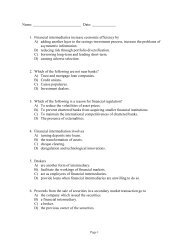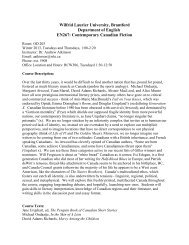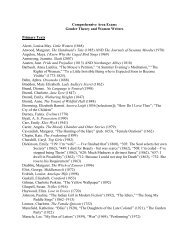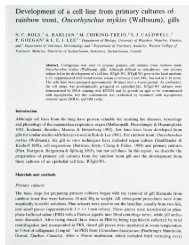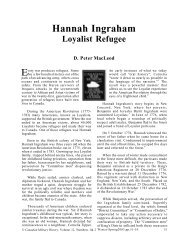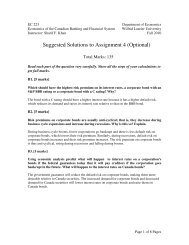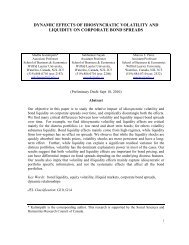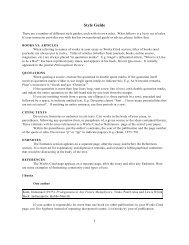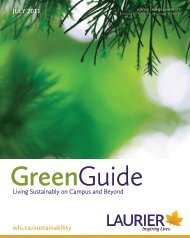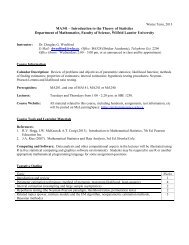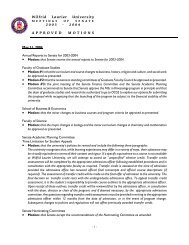Taxonomy of the Polygonum douglasii (Polygonaceae ... - WLU
Taxonomy of the Polygonum douglasii (Polygonaceae ... - WLU
Taxonomy of the Polygonum douglasii (Polygonaceae ... - WLU
You also want an ePaper? Increase the reach of your titles
YUMPU automatically turns print PDFs into web optimized ePapers that Google loves.
16 BRITTONIA<br />
[VOL. 57<br />
erotypic P. <strong>douglasii</strong> var. johnstonii that has<br />
caducous oblong-lanceolate leaves and <strong>the</strong><br />
entire plant is glabrous and more or less<br />
glaucous. However, such plants are within<br />
<strong>the</strong> range <strong>of</strong> variation <strong>of</strong> P. sawatchense<br />
subsp. sawatchense (Costea & Tardif,<br />
2003a). The stems <strong>of</strong> P. sawatchense subsp.<br />
oblivium are scaberulous papillose, <strong>the</strong><br />
leaves are oblong-elliptic to elliptic, papillose<br />
denticulate on <strong>the</strong> margins, <strong>the</strong> flowers,<br />
at least some <strong>of</strong> <strong>the</strong>m, are open, and <strong>the</strong><br />
pollen belongs to <strong>the</strong> subtype A2. <strong>Polygonum</strong><br />
sawatchense subsp. sawatchense is<br />
glabrous, <strong>the</strong> leaves are linear to oblanceolate,<br />
flowers are normally closed, and <strong>the</strong><br />
pollen belongs to subtype A1 or A2. The<br />
micromorphology <strong>of</strong> perianth surface <strong>of</strong> <strong>the</strong><br />
two taxa is also different. <strong>Polygonum</strong> sawatchense<br />
subsp. oblivium has perianth<br />
lobe cells with anticlinal walls strongly sinuated<br />
and epicuticular wax pattern <strong>of</strong> type<br />
2, while subsp. sawatchense has anticlinal<br />
walls straight or weekly sinuate, and <strong>the</strong><br />
epicuticular wax pattern <strong>of</strong> type 1. <strong>Polygonum</strong><br />
sawatchense subsp. oblivium has also<br />
been frequently confused with P. austiniae<br />
and P. minimum. From P. austiniae it differs<br />
through its erect and much larger flowers<br />
and achenes. From P. minimum it is distinguished<br />
by <strong>the</strong> morphology <strong>of</strong> leaves and<br />
ocreae, stems, size <strong>of</strong> fruiting perianth and<br />
achenes, as well as <strong>the</strong> micromorphology <strong>of</strong><br />
perianth. In particular, P. minimum has<br />
leaves that are hardly reduced distally, funnelform<br />
ocreae 1–4 mm long, papillae on<br />
stems and ocreae are conical, short, with a<br />
swollen base, and flowers and achenes are<br />
usually much smaller.<br />
Distribution and ecology. Western<br />
Canada (British Columbia) and western<br />
United States. It has <strong>the</strong> same ecology as<br />
subsp. sawatchense but unlike <strong>the</strong> latter<br />
may also grow in shaded or moist places.<br />
Phenology. Flowering June–August.<br />
4. POLYGONUM ENGELMANNII Greene, Bull.<br />
Calif. Acad. Sci. 1: 125. 1885. <strong>Polygonum</strong><br />
<strong>douglasii</strong> subsp. engelmannii<br />
(Greene) Kartesz & Gandhi, Phytologia<br />
68: 424. 1990. <strong>Polygonum</strong> tenue var. microspermum<br />
Engelm., Proc. Acad. Nat.<br />
Sci. Philadelphia 1863: 75. 1864. <strong>Polygonum</strong><br />
microspermum Small, Bull. Torrey<br />
Bot. Club 19: 366. 1892. TYPE: UNITED<br />
STATES. Colorado. Jefferson Co.: Bergen<br />
Park, 14 Sep 1877, Greene s.n. (NEO-<br />
TYPE here designated: NDG).<br />
Annual herbs. Stems 4–30 cm, green or<br />
purplish brown, freely branched from base,<br />
sparsely scaberulous-papillose on <strong>the</strong> ribs to<br />
almost glabrous; papillae conical, patent,<br />
40–60 �m, Leaves: basal leaves persistent<br />
at flowering, upper leaves abruptly reduced<br />
to scale-like bracts; ocreae 3–5 mm, funnelform,<br />
scaberulous-papillose to glabrous,<br />
free part becoming lacerate with age; blades<br />
linear-oblanceolate, 10–20(–25) � 1–3(–4)<br />
mm; margins revolute, smooth; apex acute<br />
to mucronate. Papillae on <strong>the</strong> ocreae are<br />
similar to those present on <strong>the</strong> stems. Inflorescences<br />
terminal, elongate spike-like<br />
thyrses, loose floriferous nearly to base;<br />
cymes (1–)2–4-flowered, regularly spaced<br />
along <strong>the</strong> stems and branches; bracts equaling<br />
or somewhat longer than <strong>the</strong> flowers.<br />
Flowers closed; pedicels reflexed, 1–3 mm;<br />
perianth 1.5–2(–2.5) mm; tube 18–26% <strong>of</strong><br />
<strong>the</strong> perianth length, perianth lobes almost<br />
sepaloid, initially cucullate, later � flat, naviculate,<br />
forced apart by <strong>the</strong> developing<br />
achene (Fig. 3I), greenish or sometimes<br />
purple, with narrow white margins, midveins<br />
darker, unbranched; perianth lobe<br />
cells elongated, 45–65 � 5–8 �m, with <strong>the</strong><br />
anticlinal walls strongly sinuate; epicuticular<br />
wax pattern <strong>of</strong> type 2, with a narrow<br />
longitudinal pattern <strong>of</strong> reticulate rodlets at<br />
<strong>the</strong> top <strong>of</strong> cells (Fig. 5C). Stamens 5–8, an<strong>the</strong>rs<br />
pink to purple, 128–158 �m, Pollen<br />
<strong>of</strong> subtype A1, 22.3–23.7 �m. Achenes elliptic,<br />
1.2–2.3 mm, mostly exserted from<br />
<strong>the</strong> perianth at maturity, smooth.<br />
As in <strong>the</strong> case <strong>of</strong> P. nuttallii (see below),<br />
<strong>the</strong> collection quoted by Hitchcock (1964)<br />
is formally typified here. <strong>Polygonum</strong> engelmannii<br />
is closely related to P. <strong>douglasii</strong> and<br />
P. austiniae. The three species have in common<br />
reflexed pedicels, short an<strong>the</strong>rs, and<br />
<strong>the</strong> A1 subtype <strong>of</strong> pollen. However, <strong>the</strong> diminutive<br />
habit, small, funnelform ocreae,<br />
fruiting perianth, and achenes distinguish<br />
<strong>the</strong> former from P. <strong>douglasii</strong>. Although it<br />
may appear similar to P. austiniae, P. engelmannii<br />
is distinguished by its linear-oblanceolate<br />
leaves and exserted achenes. Ad-



